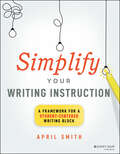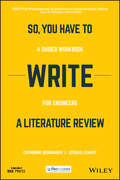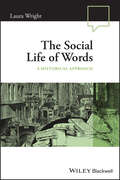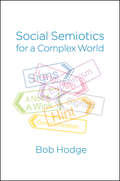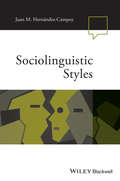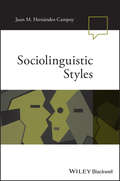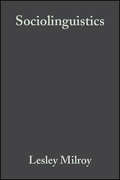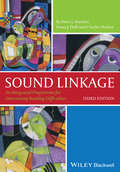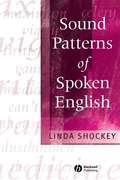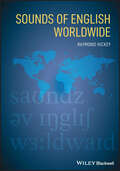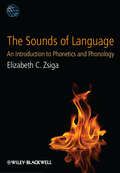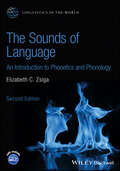- Table View
- List View
Shakespeare's Theater: A Sourcebook
by Tanya PollardShakespeare’s Theater: A Sourcebook brings together in one volume the most significant Elizabethan and Jacobean texts on the morality of the theater. A collection of the most significant Elizabethan and Jacobean texts on the morality of the theater. Includes attacks on the stage by moralists, defences by actors and playwrights, letters by magistrates, mayors and aldermen of London, and extracts from legislation. Demonstrates just how heated debates about the theater became in the late sixteenth and early seventeenth centuries. A general introduction and short prefaces to each piece situate the writers and debates in the literary, social, political and religious history of the time. Brings together in one volume texts that would otherwise be hard to locate. Student-friendly - uses modern spelling and includes vocabulary glosses and annotation.
Shakespeare's Theatre: A History
by Richard DuttonShakespeare’s Theatre: A History examines the theatre spaces used by William Shakespeare, and explores these spaces in relation to the social and political framework of the Elizabethan era. The text journeys from the performing spaces of the provincial inns, guild halls and houses of the gentry of the Bard’s early career, to the purpose-built outdoor playhouses of London, including the Globe, the Theatre, and the Curtain, and the royal courts of Elizabeth and James I. The author also discusses the players for whom Shakespeare wrote, and the positioning—or dispositioning—of audience members in relation to the stage. Widely and deeply researched, this fascinating volume is the first to draw on the most recent archaeological work on the remains of the Rose and the Globe, as well as continuing publications from the Records of Early English Drama project. The book also explores the contentious view that the ‘plot’ of The Seven Deadly Sins (part II), provides unprecedented insight into the working practices of Shakespeare’s company and includes a complete and modernized version of the ‘plot’. Throughout, the author relates the practicalities of early modern playing to the evolving systems of aristocratic patronage and royal licensing within which they developed Insightful and engaging, Shakespeare’s Theatre is ideal reading for undergraduates, postgraduates, and scholars of literature and theatre studies.
Shakespeare's Theatre: A History
by Richard DuttonShakespeare’s Theatre: A History examines the theatre spaces used by William Shakespeare, and explores these spaces in relation to the social and political framework of the Elizabethan era. The text journeys from the performing spaces of the provincial inns, guild halls and houses of the gentry of the Bard’s early career, to the purpose-built outdoor playhouses of London, including the Globe, the Theatre, and the Curtain, and the royal courts of Elizabeth and James I. The author also discusses the players for whom Shakespeare wrote, and the positioning—or dispositioning—of audience members in relation to the stage. Widely and deeply researched, this fascinating volume is the first to draw on the most recent archaeological work on the remains of the Rose and the Globe, as well as continuing publications from the Records of Early English Drama project. The book also explores the contentious view that the ‘plot’ of The Seven Deadly Sins (part II), provides unprecedented insight into the working practices of Shakespeare’s company and includes a complete and modernized version of the ‘plot’. Throughout, the author relates the practicalities of early modern playing to the evolving systems of aristocratic patronage and royal licensing within which they developed Insightful and engaging, Shakespeare’s Theatre is ideal reading for undergraduates, postgraduates, and scholars of literature and theatre studies.
Shakespeare's Tragedies (Blackwell Guides to Criticism #25)
by Emma SmithThis Guide steers students through the critical writing on Shakespeare’s tragedies from the sixteenth century to the present day. Guides students through four centuries of critical writing on Shakespeare’s tragedies. Covers both significant early views and recent critical interventions. Substantial editorial material links the articles and places them in context. Annotated suggestions for further reading allow students to investigate further.
A Short History of Early Modern England: British Literature in Context
by Peter C. HermanA Short History of Early Modern England presents the historical and cultural information necessary for a richer understanding of English Renaissance literature. Written in a clear and accessible style for an undergraduate level audience Gives an overview of the period’s history as well as an understanding of the historiographic issues Explores key historical and literary events, from the Wars of the Roses to the publication of John Milton’s Paradise Regained Features in depth explanations of key terms and concepts, such as absolutism and the Elizabethan Settlement
A Short History of Early Modern England: British Literature in Context
by Peter C. HermanA Short History of Early Modern England presents the historical and cultural information necessary for a richer understanding of English Renaissance literature. Written in a clear and accessible style for an undergraduate level audience Gives an overview of the period’s history as well as an understanding of the historiographic issues Explores key historical and literary events, from the Wars of the Roses to the publication of John Milton’s Paradise Regained Features in depth explanations of key terms and concepts, such as absolutism and the Elizabethan Settlement
Simplify Your Writing Instruction: A Framework For A Student-Centered Writing Block
by April SmithSet up your writing block quickly and easily with a simple, research-based framework Schools need their writing instruction simplified. Most classrooms share writing time with another subject, making it difficult for students to receive the direct writing instruction they need. Between the lack of time, increased gaps in writing skills, and inconsistent writing curriculum, teachers are struggling to bring their students up to grade level. Simplify Your Writing Instruction provides you with a classroom-tested framework that helps you set up your writing block within the limited time and resources you have. Step by step, this practical guide shows you how to amplify your students’ writing skills, employ simple feedback opportunities and interventions, streamline your lessons, use simple differentiation techniques to help reach students of all ability levels, and more. Author April Smith is a former teacher who has trained more than 50,000 K-12 educators on best practices for writing instruction. While in the classroom, she learned that having simple and consistent systems in place is critical. Accordingly, none of the tasks and strategies will require you to create or prep anything complicated or time-consuming. In Simplify Your Writing Instruction, you will find easy-to-use checklists, implementation tasks, customizable templates, student writing samples, helpful tables and charts, and a simple spreadsheet that you can use to plan your lessons and modify your teaching to meet the needs of each writer. Be confident and supported in your writing instruction. Simplify Your Writing Instruction will teach you how to: Implement the Simple Pre-Assessment Process in your classroom Encourage authentic writing practice at home Differentiate your lessons to reach your Special Education, ELL, and Gifted students Integrate grammar naturally and optimize student output after each lesson Split the writing process into efficient and effective 10- to 15-minute mini-lessons Make writing a priority by incorporating writing application into other subjects Use a simple pre-assessment to get a better overall picture of what your students can do Utilize more complex strategies such as small group work and conferring Packed with expert advice and easy-to-follow strategies, Simplify Your Writing Instruction: A Framework for a Better Writing Block is a must-have resource for all K-12 educators and teachers in training.
Simplify Your Writing Instruction: A Framework For A Student-Centered Writing Block
by April SmithSet up your writing block quickly and easily with a simple, research-based framework Schools need their writing instruction simplified. Most classrooms share writing time with another subject, making it difficult for students to receive the direct writing instruction they need. Between the lack of time, increased gaps in writing skills, and inconsistent writing curriculum, teachers are struggling to bring their students up to grade level. Simplify Your Writing Instruction provides you with a classroom-tested framework that helps you set up your writing block within the limited time and resources you have. Step by step, this practical guide shows you how to amplify your students’ writing skills, employ simple feedback opportunities and interventions, streamline your lessons, use simple differentiation techniques to help reach students of all ability levels, and more. Author April Smith is a former teacher who has trained more than 50,000 K-12 educators on best practices for writing instruction. While in the classroom, she learned that having simple and consistent systems in place is critical. Accordingly, none of the tasks and strategies will require you to create or prep anything complicated or time-consuming. In Simplify Your Writing Instruction, you will find easy-to-use checklists, implementation tasks, customizable templates, student writing samples, helpful tables and charts, and a simple spreadsheet that you can use to plan your lessons and modify your teaching to meet the needs of each writer. Be confident and supported in your writing instruction. Simplify Your Writing Instruction will teach you how to: Implement the Simple Pre-Assessment Process in your classroom Encourage authentic writing practice at home Differentiate your lessons to reach your Special Education, ELL, and Gifted students Integrate grammar naturally and optimize student output after each lesson Split the writing process into efficient and effective 10- to 15-minute mini-lessons Make writing a priority by incorporating writing application into other subjects Use a simple pre-assessment to get a better overall picture of what your students can do Utilize more complex strategies such as small group work and conferring Packed with expert advice and easy-to-follow strategies, Simplify Your Writing Instruction: A Framework for a Better Writing Block is a must-have resource for all K-12 educators and teachers in training.
Sixteenth-Century Poetry: An Annotated Anthology (Blackwell Annotated Anthologies)
by Gordon BradenThis fully-annotated anthology of sixteenth-century English verse features generous selections from the canonical poets, alongside judicious selections from lesser-known authors. Includes complete works or substantial extracts of longer poems wherever possible, including Book III of the ‘Faerie Queene’ and the whole of ‘Astrophil and Stella’. Covers a range of genres, including the love lyric, mythological narrative, sacred poetry and political poetry. Encourages readers to discover unusual and interesting connections and contrasts between poems and poets. Detailed annotations facilitate close reading of the poems.
So, You Have to Write a Literature Review: A Guided Workbook for Engineers (IEEE PCS Professional Engineering Communication Series)
by Catherine G.P. Berdanier Joshua B. LenartIs a literature review looming in your future? Are you procrastinating on writing a literature review at this very moment? If so, this is the book for you. Writing often causes trepidation and procrastination for engineering students—issues that compound while writing a literature review, a type of academic writing most engineers are never formally taught. Consider this workbook as a “couch-to-5k” program for engineering writers rather than runners: if you complete the activities in this book from beginning to end, you will have a literature review draft ready for revision and content editing by your research advisor. So, You Have to Write a Literature Review presents a dynamic and practical method in which engineering students—typically late-career undergraduates or graduate students—can learn to write literature reviews, and translate genre-based writing instruction into easy-to-follow, bite-sized activities and content. Written in a refreshingly conversational style while acknowledging that writing is quite difficult, Catherine Berdanier and Joshua Lenart leverage their unique disciplinary backgrounds with decades of experience teaching academic engineering writing in this user-friendly workbook
So, You Have to Write a Literature Review: A Guided Workbook for Engineers (IEEE PCS Professional Engineering Communication Series)
by Catherine G.P. Berdanier Joshua B. LenartIs a literature review looming in your future? Are you procrastinating on writing a literature review at this very moment? If so, this is the book for you. Writing often causes trepidation and procrastination for engineering students—issues that compound while writing a literature review, a type of academic writing most engineers are never formally taught. Consider this workbook as a “couch-to-5k” program for engineering writers rather than runners: if you complete the activities in this book from beginning to end, you will have a literature review draft ready for revision and content editing by your research advisor. So, You Have to Write a Literature Review presents a dynamic and practical method in which engineering students—typically late-career undergraduates or graduate students—can learn to write literature reviews, and translate genre-based writing instruction into easy-to-follow, bite-sized activities and content. Written in a refreshingly conversational style while acknowledging that writing is quite difficult, Catherine Berdanier and Joshua Lenart leverage their unique disciplinary backgrounds with decades of experience teaching academic engineering writing in this user-friendly workbook
The Social Life of Words: A Historical Approach (Language in Society)
by Laura WrightA new approach to sociolinguistics, introducing the study of the social meaning of English words over time, and offering an engaging and entertaining demonstration of lexical sociolinguistic analysis The Social Life of Words: A Historical Approach explores the rise and fall of the social properties of words, charting ways in which they take on new social connotations. Written in an engaging narrative style, this entertaining text matches up sociolinguistic theory with social history and biography to discover which kind of people used what kind of word, where and when. Social factors such as class, age, race, region, gender, occupation, religion and criminality are discussed in British and American English. From familiar words such as popcorn, porridge, café, to less common words like burgoo, califont, etna, and phrases like kiss me quick, monkey parade, slap-bang shop, The Social Life of Words demonstrates some of the many ways a new word or phrase can develop social affiliations. Detailed yet accessible chapters cover key areas of historical sociolinguistics, including concepts such as social networks, communities of practice, indexicality and enregisterment, prototypes and stereotypes, polysemy, onomasiology, language regard, lexical appropriation, and more. The first book to take a focused look at lexis as a topic for sociolinguistic analysis, The Social Life of Words: Introduces sociolinguistic theories and shows how they can be applied to the lexicon Demonstrates how readers can apply sociolinguistic theory to their own analyses of words in English and other languages Provides an engaging and amusing new look at many familiar words, inviting students to explore the sociolinguistic properties of words over time for themselvesPart of Wiley Blackwell’s acclaimed Language in Society series, The Social Life of Words is essential reading for upper-level undergraduate students, graduate students, postdoctoral researchers, and linguists working in sociolinguistics, lexical semantics, English lexicology, and the history and development of modern English.
The Social Life of Words: A Historical Approach (Language in Society)
by Laura WrightA new approach to sociolinguistics, introducing the study of the social meaning of English words over time, and offering an engaging and entertaining demonstration of lexical sociolinguistic analysis The Social Life of Words: A Historical Approach explores the rise and fall of the social properties of words, charting ways in which they take on new social connotations. Written in an engaging narrative style, this entertaining text matches up sociolinguistic theory with social history and biography to discover which kind of people used what kind of word, where and when. Social factors such as class, age, race, region, gender, occupation, religion and criminality are discussed in British and American English. From familiar words such as popcorn, porridge, café, to less common words like burgoo, califont, etna, and phrases like kiss me quick, monkey parade, slap-bang shop, The Social Life of Words demonstrates some of the many ways a new word or phrase can develop social affiliations. Detailed yet accessible chapters cover key areas of historical sociolinguistics, including concepts such as social networks, communities of practice, indexicality and enregisterment, prototypes and stereotypes, polysemy, onomasiology, language regard, lexical appropriation, and more. The first book to take a focused look at lexis as a topic for sociolinguistic analysis, The Social Life of Words: Introduces sociolinguistic theories and shows how they can be applied to the lexicon Demonstrates how readers can apply sociolinguistic theory to their own analyses of words in English and other languages Provides an engaging and amusing new look at many familiar words, inviting students to explore the sociolinguistic properties of words over time for themselvesPart of Wiley Blackwell’s acclaimed Language in Society series, The Social Life of Words is essential reading for upper-level undergraduate students, graduate students, postdoctoral researchers, and linguists working in sociolinguistics, lexical semantics, English lexicology, and the history and development of modern English.
Social Semiotics for a Complex World: Analysing Language and Social Meaning
by Bob HodgeSocial semiotics reveals language's social meaning – its structures, processes, conditions and effects – in all social contexts, across all media and modes of discourse. This important new book uses social semiotics as a one-stop shop to analyse language and social meaning, enhancing linguistics with a sociological imagination. Social Semiotics for a Complex World develops ideas, frameworks and strategies for better understanding key problems and issues involving language and social action in today's hyper-complex world driven by globalization and new media. Its semiotic basis incorporates insights from various schools of linguistics (such as cognitive linguistics, critical discourse analysis and sociolinguistics) as well as from sociology, anthropology, philosophy, psychology and literary studies. It employs a multi-modal perspective to follow meaning across all modes of language and media, and a multi-scalar approach that ranges between databases and one-word slogans, the local and global, with examples from English, Chinese and Spanish. Social semiotics analyses twists and turns of meanings big and small in complex contexts. This book uses semiotic principles to build a powerful, flexible analytic toolkit which will be invaluable for students across the humanities and social sciences.
Sociolinguistic Styles (Language in Society)
by Juan Manuel Hernández-CampoySociolinguistic Styles presents a new and in-depth, historically rooted overview of the phenomenon of style-shifting in sociolinguistic variation. Written by an internationally acclaimed expert in the field, the text explores why, where and when it occurs. Full examination of the complex phenomenon of style-shifting in sociolinguistics, focusing on its nature and social motivations, as well as on the mechanisms for its usage and its effects In-depth, up-to-date critical overview of the different theoretical approaches accounting for stylistic variation, exploring their historical roots not only in sociolinguistics and stylistics or semiotics but also in classical fields such as rhetoric and oratory Coverage of a wide range of related concepts and issues, from the oldest Greek ethos and pathos or Roman elocutio and pronuntiatio to the contemporary enregisterment, stylisation, stance, or crossing Written by an academic who has been instrumental in developing theory in this area of sociolinguistics
Sociolinguistic Styles (Language in Society)
by Juan Manuel Hernández-CampoySociolinguistic Styles presents a new and in-depth, historically rooted overview of the phenomenon of style-shifting in sociolinguistic variation. Written by an internationally acclaimed expert in the field, the text explores why, where and when it occurs. Full examination of the complex phenomenon of style-shifting in sociolinguistics, focusing on its nature and social motivations, as well as on the mechanisms for its usage and its effects In-depth, up-to-date critical overview of the different theoretical approaches accounting for stylistic variation, exploring their historical roots not only in sociolinguistics and stylistics or semiotics but also in classical fields such as rhetoric and oratory Coverage of a wide range of related concepts and issues, from the oldest Greek ethos and pathos or Roman elocutio and pronuntiatio to the contemporary enregisterment, stylisation, stance, or crossing Written by an academic who has been instrumental in developing theory in this area of sociolinguistics
Sociolinguistics: Method and Interpretation (Language in Society #13)
by Lesley Milroy Matthew GordonSociolinguistics: Method and Interpretation presents a thorough and practical description of current sociolinguistic methodology while recognizing that methodological decisions can never be separated from questions of theory. Presents a thorough and practical description of current sociolinguistic methodology. Considers a range of issues including speaker selection, data collection, social considerations, phonological and syntactical variation, style-shifting and code-switching. Recognizes that methodological decisions can never be separated from questions of theory. Stresses the need for the entire research process from the initial design of the project to the interpretation of results to be grounded in theoretically defensible positions. Shows how the research paradigm established by a few influential pioneers has been fruitfully expanded by exciting new trends.
Sound Linkage: An Integrated Programme for Overcoming Reading Difficulties
by Peter J. Hatcher Fiona J. Duff Charles HulmeThe updated edition of this successful resource has been developed to support children with reading delays and dyslexia. It contains a phonological training programme, an explanation of how this programme can be embedded within a broader reading intervention, a standardized test of phonological awareness and a methodology to grade children’s reading books. This third edition has been revised throughout to include the latest developments in the field These resources have been used with a wide range of children and found to be suitable for use with any reading-delayed children, irrespective of cognitive ability and age All activities are accompanied by a set of photocopiable record sheets, a set of pictures, and an appendix of additional activities useful in helping children master a particular skill or to reinforce existing learning The ten sections of activities within the guide include: identification of words and syllables; identification and supply of rhyming words; identification and discrimination of phonemes; and blending, segmentation, deletion, substitution and transposition of phonemes within words.
Sound Linkage: An Integrated Programme for Overcoming Reading Difficulties
by Peter J. Hatcher Fiona J. Duff Charles HulmeThe updated edition of this successful resource has been developed to support children with reading delays and dyslexia. It contains a phonological training programme, an explanation of how this programme can be embedded within a broader reading intervention, a standardized test of phonological awareness and a methodology to grade children’s reading books. This third edition has been revised throughout to include the latest developments in the field These resources have been used with a wide range of children and found to be suitable for use with any reading-delayed children, irrespective of cognitive ability and age All activities are accompanied by a set of photocopiable record sheets, a set of pictures, and an appendix of additional activities useful in helping children master a particular skill or to reinforce existing learning The ten sections of activities within the guide include: identification of words and syllables; identification and supply of rhyming words; identification and discrimination of phonemes; and blending, segmentation, deletion, substitution and transposition of phonemes within words.
Sound Patterns of Spoken English
by Linda ShockeySound Patterns of Spoken English is a concise, to-the-point compendium of information about the casual pronunciation of everyday English as compared to formal citation forms. Concise, to-the-point compendium of information about casual pronunciation of English as compared to citation forms. Covers varieties of English language including General American and Standard Southern British. Overlaps the boundaries of several areas of study including sociolinguistics, lexicography, rhetoric, and speech sciences. Examines English pronunciation as found in everyday speech. Accompanied by website at http://www.blackwellpublishing.com/shockey featuring examples from different accents.
Sounds of English Worldwide
by Raymond HickeyAn in-depth exploration of the sound systems of varieties of English around the world, written by a renowned authority in the field In Sounds of English Worldwide, Raymond Hickey delivers a rigorous overview of the sound systems of varieties of English throughout the world. Beginning with an overview of the history and contexts of global varieties of English, this book guides readers through the spread of English during the colonial era leading up to the present day. The second section of the book broadly considers developments in the English-speaking world, accounting for the factors that triggered regional changes and resulted in diverse scenarios for English, including language contact and shift, new dialect formation , and the use of English in non-anglophone contexts. To assist students in learning how to approach the study of varieties of English, this valuable text addresses research questions of general interest to linguists and explores a variety of fieldwork methods commonly used by researchers in the area. This useful book offers: A thorough introduction to English today, including its geographical and social distribution, focusing on variation and change around the world Practical discussions of key changes in late modern English that determined the unique phonetic profile of different varieties of the language In-depth examination of present-day scenarios and how they might pan out in the future development of English, considering the many factors which may shape global forms of the language Includes useful summaries of varieties of English with a glossary and timeline, providing a quick reference of the key features of English around the world for students Considers research issues and methods to aid students in applying the material of the book to their own studiesPerfect for graduate students, advanced undergraduate students, and researchers studying varieties of Englishes, Sounds of English Worldwide will earn a place in the libraries of linguists and students studying Englishes worldwide from a sociolinguistic perspective as well as langague contact , bilingualism, the rise of new varieties along with English phonetics and phonology more generally.
Sounds of English Worldwide
by Raymond HickeyAn in-depth exploration of the sound systems of varieties of English around the world, written by a renowned authority in the field In Sounds of English Worldwide, Raymond Hickey delivers a rigorous overview of the sound systems of varieties of English throughout the world. Beginning with an overview of the history and contexts of global varieties of English, this book guides readers through the spread of English during the colonial era leading up to the present day. The second section of the book broadly considers developments in the English-speaking world, accounting for the factors that triggered regional changes and resulted in diverse scenarios for English, including language contact and shift, new dialect formation , and the use of English in non-anglophone contexts. To assist students in learning how to approach the study of varieties of English, this valuable text addresses research questions of general interest to linguists and explores a variety of fieldwork methods commonly used by researchers in the area. This useful book offers: A thorough introduction to English today, including its geographical and social distribution, focusing on variation and change around the world Practical discussions of key changes in late modern English that determined the unique phonetic profile of different varieties of the language In-depth examination of present-day scenarios and how they might pan out in the future development of English, considering the many factors which may shape global forms of the language Includes useful summaries of varieties of English with a glossary and timeline, providing a quick reference of the key features of English around the world for students Considers research issues and methods to aid students in applying the material of the book to their own studiesPerfect for graduate students, advanced undergraduate students, and researchers studying varieties of Englishes, Sounds of English Worldwide will earn a place in the libraries of linguists and students studying Englishes worldwide from a sociolinguistic perspective as well as langague contact , bilingualism, the rise of new varieties along with English phonetics and phonology more generally.
The Sounds of Language: An Introduction to Phonetics and Phonology (Linguistics in the World #7)
by Elizabeth C. ZsigaThe Sounds of Language is an introductory guide to the linguistic study of speech sounds, which provides uniquely balanced coverage of both phonology and phonetics. Features exercises and problem sets, as well as supporting online resources at www.wiley.com/go/zsiga, including additional discussion questions and exercises, as well as links to further resources such as sound files, video files, and useful websites Creates opportunities for students to practice data analysis and hypothesis testing Integrates data on sociolinguistic variation, first language acquisition, and second language learning Explores diverse topics ranging from the practical, such as how to make good digital recordings, make a palatogram, solve a phoneme/allophone problem, or read a spectrogram; to the theoretical, including the role of markedness in linguistic theory, the necessity of abstraction, features and formal notation, issues in speech perception as distinct from hearing, and modelling sociolinguistic and other variations Organized specifically to fit the needs of undergraduate students of phonetics and phonology, and is structured in a way which enables instructors to use the text both for a single semester phonetics and phonology course or for a two-course sequence
The Sounds of Language: An Introduction to Phonetics and Phonology (Linguistics in the World)
by Elizabeth C. ZsigaThe Sounds of Language is an introductory guide to the linguistic study of speech sounds, which provides uniquely balanced coverage of both phonology and phonetics. Features exercises and problem sets, as well as supporting online resources at www.wiley.com/go/zsiga, including additional discussion questions and exercises, as well as links to further resources such as sound files, video files, and useful websites Creates opportunities for students to practice data analysis and hypothesis testing Integrates data on sociolinguistic variation, first language acquisition, and second language learning Explores diverse topics ranging from the practical, such as how to make good digital recordings, make a palatogram, solve a phoneme/allophone problem, or read a spectrogram; to the theoretical, including the role of markedness in linguistic theory, the necessity of abstraction, features and formal notation, issues in speech perception as distinct from hearing, and modelling sociolinguistic and other variations Organized specifically to fit the needs of undergraduate students of phonetics and phonology, and is structured in a way which enables instructors to use the text both for a single semester phonetics and phonology course or for a two-course sequence
The Sounds of Language: An Introduction to Phonetics and Phonology (Linguistics in the World)
by Elizabeth C. ZsigaThe fully updated, new edition of the bestselling introduction to phonetics and phonology The Sounds of Language presents a comprehensive introduction to both the physical and cognitive aspects of speech sounds. Assuming no prior knowledge of phonetics or phonology, this student-friendly textbook clearly explains fundamental concepts and theories, describes key phonetic and phonological phenomena, explores the history and intersection of the two fields, offers practical advice on collecting and reading data, and more. Twenty-four concise chapters, written in non-technical language, are organized into six sections that each focus on a particular sub-discipline: Articulatory Phonetics, Acoustic Phonetics, Segmental Phonology, Suprasegmental Phonology, the Phonology/Morphology Interface, and Variation and Change. The book's flexible modular approach allows instructors to easily choose, re-order, combine, or skip sections to meet the needs of one- and two-semester courses of varying levels. Now in its second edition, The Sounds of Language contains updated references, new problem sets, new examples, and links to new online material. The new edition features new chapters on Lexical Phonology; Word Structure and Sound Structure; and Variation, Probability, and Phonological Theory. Chapters on Sociolinguistic Variation, Child Language Acquisition, and Adult Language Learning have also been extensively updated and revised. Offering uniquely broad and balanced coverage of the theory and practice of two major branches of linguistics, The Sounds of Language: Covers a wide range of topics in phonetics and phonology, from the anatomy of the vocal tract to the cognitive processes behind the comprehension of speech sounds Features critical reviews of different approaches that have been used to address phonetics and phonology problems Integrates data on sociolinguistic variation, first language acquisition, and second language learning Surveys key phonological theories, common phonological processes, and computational techniques for speech analysis Contains numerous exercises and progressively challenging problem sets that allow students to practice data analysis and hypothesis testing Includes access to a companion website with additional exercises, sound files, and other supporting resources The Sounds of Language: An Introduction to Phonetics and Phonology, Second Edition, remains the ideal textbook for undergraduate and beginning graduate classes on phonology and phonetics, as well as related courses in linguistics, applied linguistics, speech science, language acquisition, and cognitive science programs.




